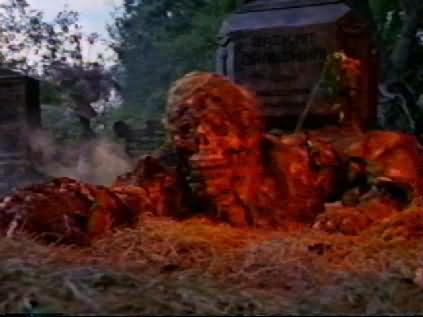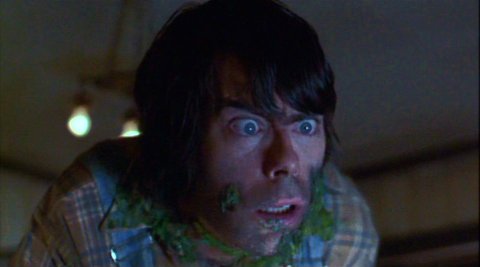In 1980, George Romero tried to step away from horror with KNIGHTRIDERS, a tale of medieval combatants who followed a king and jousted on motorcycles. Though the story was close to his heart, it wasn’t horror; and so for the second time in his career, Romero felt obliged to return to the genre, where he was and still is an acknowledged master. His next film would prove an inspired collaboration with another acknowledge master, bestselling author Stephen King. The end product was CREEPSHOW, a portmanteau film that owed its witty tone and moral aptitude to the E.C. Comics of a generation earlier. It’s also an excellent return to form.
A little background on the relationship: After MARTIN, the suits at Warner Bros. studios asked Romero to direct an adaptation of King’s novel ‘Salem’s Lot. According to Romero, it seemed like a natural fit: a guy who’d directed a movie about a vampire in a small, modern town helming a work based on a novel about a vampire in a small, modern town. Romero met King and the two hit it off famously. But when Warner Bros. changed track and decided to turn the project into a made-for-TV movie, Romero felt he couldn’t restrain from the gore effects, and he passed. King and Romero then discussed a collaboration on The Stand, another project which never came to fruition. Instead, Romero followed his mega-success DAWN OF THE DEAD with KNIGHTRIDERS, and herein lie the seed for his next project; look closely, and you’ll see King portraying a sandwich-eating, beer guzzling critic during the first joust. Now returning to the genre where people loved and accepted him, Romero got together with King and planned out CREEPSHOW. King would write five segments, and a wrap-around; Romero would bring his visual style, editing prowess and a wicked glee to the proceedings.
What Romero would not bring was his famous social commentary. Instead, he brought a moral commentary. CREEPSHOW is essentially an ode to E.C. Comics, where terribly bad things happen to terribly bad people. Each segment is a morality play, in which cosmic punishment is meted out in the most gruesome fashions, poetic justice in which the nasties truly get what they deserve. Romero still gets to comment on the darker side of the human condition, but in a wholly fresh way.
Don’t worry, though. From the very first frames, this is classic Romero: a father bitching at his son about reading a horror mag named Creepshow. After slapping the kid around and tossing the magazine, he sits down to enjoy a cold beer, informing us, “That’s why God made fathers.” Alone in his room, the kid curses his dad, until The Creep, a a desiccated, ghostlike thing floats outside his window, beckoning him to join her in the magazine’s world. This bring the audience right into the first story, and all the way through the four to follow.

“Father’s Day” has always been my favorite of the five. At a family gathering, it’s revealed to newcomer Henry that Aunt Bedelia murdered her callous, overbearing father. Through flashbacks, we get to see just what a mean old bastard he was, and Bedelia becomes more sympathetic because of it. But dear old dad just won’t rest until he gets his cake. Viveca Lindfors is excellent as the unhinged, eccentric Bedelia, and her crooked hat and smoking style quickly delineate the character; her graveside conversation with her father reveals her pain and frustration, and makes her easy to sympathize with. John Amplas is fun as the skeletal, zombified father, who manages to be both humorous and scary in his quest for dessert; he even makes the clichéd hand thrusting from the grave a joy . And kudos to Ed Harris, so serious in KNIGHTRIDERS, for pulling off the most hilarious dance moves ever committed to film. “Father’s Day” best captures the proper balance between morbid humor and straight up horror that E. C. reveled in. It also best serves Romero thematically, taking an everyday situation, turning it upside down, and never restoring order.

“The Lonesome Death of Jordy Verrill” follows, and it’s the silliest of the five. King plays the title simpleton, a farmer content to work the land and watch WWF wrestling, until a meteor lands in his backyard. Jordy has visions of grandeur in his head, about how he will become rich and famous off his find; later, after the meteor splits in two, his visions focus on what a lunkhead he is. But he’s got bigger problems than his dreams, as his contact with the rock from outer space has an unpleasant side effect on his body. King plays the whole segment for goofs, with bugged out eyes and a hick’s accent. If anything, it makes the horrific ending more jarring. It’s another good segment that lightens things up a bit.
“Something to Tide You Over” is next, and it’s the closest to straight horror that CREEPSHOW provides. Richard Vickers has discovered his wife is cheating on him with Harry Wentworth. He brings Harry down to the beach, with plans of burying him and leaving him for the tide. But as Romero and E. C. have both taught us, that which is dead doesn’t always stay dead. A ghoulish, seaweed comeuppance awaits Richard. Leslie Nielsen and Ted Danson are great as adversaries, playing off each other as Richard holds the upper hand. Danson does a solid job of portraying the growing terror, as the tide rises. Nielsen, who will be best remembered as silly cop Frank Dreben, knows exactly how to turn Vickers into a detestable prick. This segment is very similar to King’s story “The Ledge,” which would show up a few years in another portmanteau, CAT’S EYE. It’s another solid entry.
Next in line is “The Crate,” based on an unpublished King story. Henry Northrup is a college professor whose wife is a total bitch. At a social gathering, she takes every opportunity to slam him, driving him to the point where he imagines shooting her in the head, Dirty Harry style. Looking for a way to snuff out his wife, he finds exactly what he needs in a crate under the stairs at his university. Hal Holbrook does well as the beleaguered husband, Adrienne Barbeau is fabulous as the cartoonish hag of a wife, and there’s a solid performance by Fritz Weaver, of TWILIGHT ZONE fame. This segment relishes in the balance of humor and horror, and it’s a highlight of the film. And Fluffy, the thing in the crate, qualifies as one of the best effects in CREEPSHOW.
“They’re Creeping Up On You” rounds out the movie, and it’s the weakest of the bunch. E. G. Marshall plays Upson Pratt, a germaphobe who takes his obsession so far that he’s made himself a hermetically sealed apartment where no dirt or disease can get it. But as the title implies, Pratt is far from safe as thousands upon thousands of cockroaches find a way into the airtight room, spoiling the sterility of the place. My main problem with this segment is that it’s not really scary at all; it’s just disgusting. Sure, cockroaches are gross, and being buried under a sea of them will make the skin crawl, but it’s not really horror material. That this segment is last is a special disappointment, as it doesn’t equal the fun of its four counterparts, and ends things on a down note.
One more surprise follows, as CREEPSHOW concludes with our loving father from the wrap-around. Do I really need to hint at what happens to him? I thought not.
Of special note is the animation of Rick Catizone. He put together the still shots that end NIGHT OF THE LIVING DEAD, and here he’s given a much more ambitious assignment. CREEPSHOW is really a live-action comic book, and Catizione created the comic pages that introduce each segment, right down to the ads for electric hand buzzers. Even more impressive is his work within each segment. Several times the screen splits into a number of panels, portraying several events as they would appear in a comic. There are also times when he frames a part of the action, leaving the rest of the screen black. There are even screen wipes that look as if one is turning pages. DP Mike Gornick does a fantastic job of lighting characters in garish fashion, so they pop right off the screen and sell the vivid colors. I can’t remember another film that has drawn me into itself as if I were in a whole other medium. This makes CREEPSHOW truly unique, and is also one of the many elements that make it a great joy.
This is also Romero’s first time working with established actors, such as Holbrook, Marshall, Weaver and Lindfors. He gets interesting performances from them, proving he could do more than direct amateur and stage actors.
Had KNIGHTRIDERS been a big hit, Romero may never have returned to horror. Though I enjoy that film, I can’t say I’m disappointed he came back to the genre. CREEPSHOW serves as an excellent return to form, and a top notch collaboration between two of horror’s legendary talents. It’s a love letter to a great comic book that inspired both men throughout their careers, especially in this film, loaded with morality plays that see bad people being ended badly. Romero and King are on top of their games here, and it’s ghoulish fun, even if it’s not why fathers were made.
-Phil Fasso